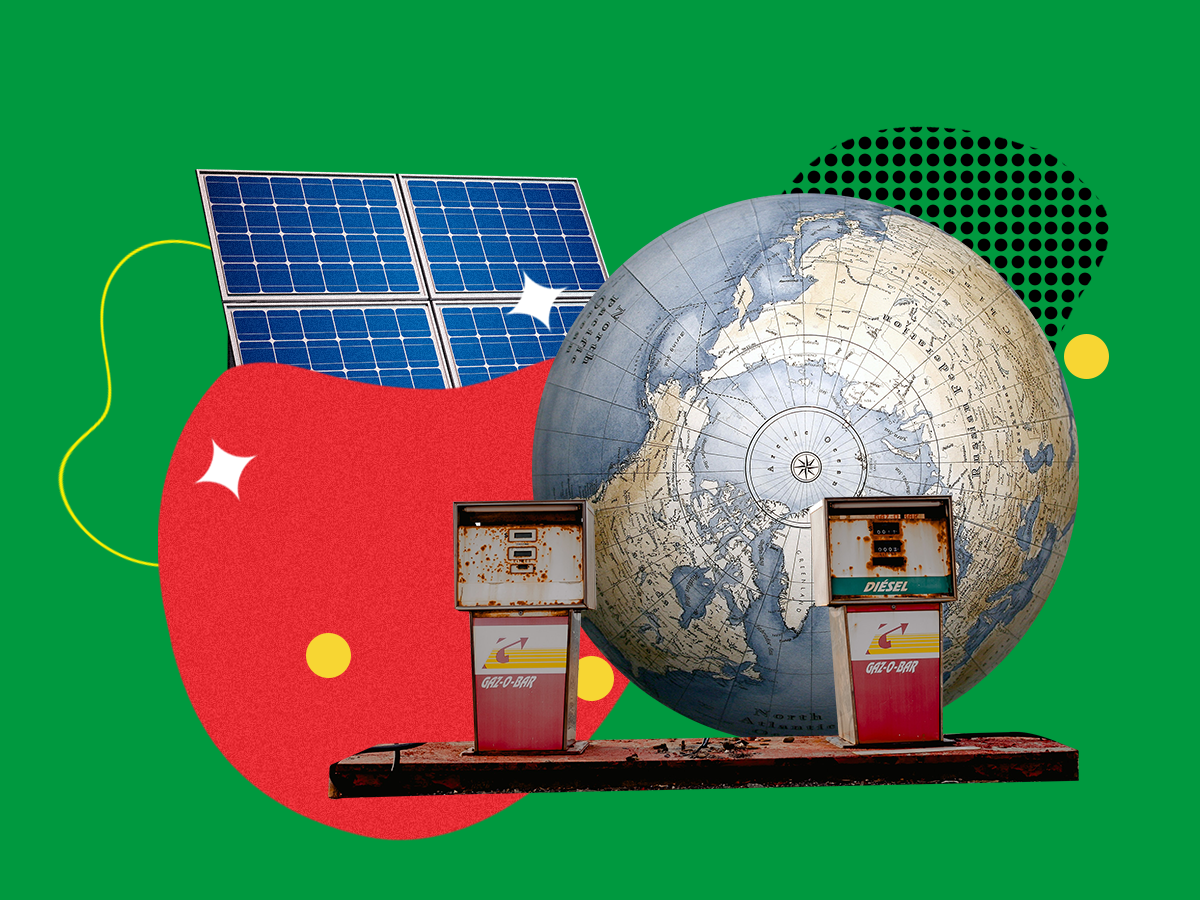Sustainable Investing: How to Stop Funding Climate Change With Your Money
Past performance is no guarantee of future results—or even a future at all.

Not to be dramatic, but the world is on fire, and it’s expensive.
Just last year, wildfires, hurricanes and droughts cost local and federal governments in the U.S. close to $100 billion in damages. In the stock market, shareholders are growing worried about the long-term profitability of fossil fuel investments. Scientists tell us to keep what’s left of the world’s oil and coal reserves—somewhere between just 30 and 70 years’ worth—in the ground. So can it really be financially prudent to keep investing in companies like Shell, Exxon and Chevron unless they change their business model to be less reliant on diminishing resources?
Anyone with a 401(k), IRA or other kind of investment account has probably felt this growing sense of cognitive dissonance. One one hand, investing for retirement (as opposed to keeping your extra cash in a normal savings account) is perhaps the most responsible way to make sure you’ll have enough money as you age. But on the other hand, how responsible (and financially wise, for that matter) is it to invest in companies and industries that aren’t thinking more than 30 years into the future?
That’s where sustainable investing comes in. If you’re feeling conflicted about skeletons you might find inside your portfolio, read on to learn about the umbrella of “ESG” investing, where a few forward-thinking alternatives exist.
What is ESG investing?
The acronym “ESG” stands for environmental, social and (corporate) governance. ESG investing has been on the rise since the mid-2000s, and it’s recently come to reference a growing segment of impact investors, shareholder activists and corporate analysts dedicated to doing good by trading on Wall Street.
ESG indicators include environmental criteria (like a company’s greenhouse gas emissions, rate of renewable energy usage, pollution, and/or treatment of animals), social criteria (like whether a company donates a portion of its profits to human rights organizations), and governance criteria (whether a company is transparent and/or allows its stakeholders to vote on important matters).
Financial products are evaluated on these indicators so that members of the general public can have some sense of what their money would support if they were to store it in certain banks or invest in particular funds.
But before you run down to the nearest climate rally to celebrate, remember that ESG investing is still relatively new. Profit remains the top priority across the financial sector — and that probably won’t change any time soon, according to Boris Khentov, SVP of operations and sustainable investing at Betterment, a U.S. financial advisory company.
“As fiduciaries, helping our clients secure their financial futures remains our number-one objective always,” says Khentov. “But for a long time sustainable investing has been sort of plagued with institutional jargon. We now see our job as advisors to make sense of this entire new world.”
Here’s what that new world looks like.
Options for sustainable investing
Divestment
If you’ve heard of Fire Drill Fridays, you’re probably familiar with the call for corporations, people and institutions to divest from the fossil fuel industry, as well as problematic industries like weapon manufacturing, private prisons and privately-funded migrant detention facilities.
Divestment is simply reducing your amount of shares in a company or industry. The way to do that is, of course, to sell them. This is likely going to make you feel good, but just remember that if everyone sold shares at high volumes, it would drive the price down, and profit-hungry investors could more easily get their hands on cheap securities to later profit off of.
Therefore, divestment is only one strategy for sustainable investing.
Investment
The opposite of divestment is investment. Last year, the University of Toronto made headlines for investing its $7 billion endowment in the debt of companies committed to lowering their carbon footprint.
Everyday investors can also choose to invest strategically in companies or industries committed to sustainability, particularly if you prefer active over passive investing. However, cherry-picking stocks is one of the riskiest investment strategies for individuals, so it may be best to explore more passive, low-cost ways to build a diverse and socially-responsible investment (SRI) portfolio.
Out of all investment options, index funds and ETFs tend to have the lowest fees and the broadest diversification. Compared to individual stocks, these funds are made up of a mix of company securities, whether across a particular sector, size or industry. Check with a broker or advisory firm to learn what SRI fund options exist.
Another option is low- or no-fee mutual funds or Individual Retirement Accounts (IRAs). Aspiration has a $10 minimum to open a 100% fossil fuel-free retirement and/or investment account. Signing up for the platform also includes a debit card which earns 0.5% cash back on purchases at sustainable businesses.
Choosing an advisor for sustainable investing
While the Vanguards of the world will likely offer the lowest advisory fees for most SRI funds, a smaller financial advisory may be advantageous when you want to nimbly adapt to the changing landscape of sustainable investing. Larger advisories are not always set up to quickly swap out securities, especially inside the most popular flagship funds such as the Vanguard Total Stock Market ETF (VTI). (Like its name suggests, this fund seeks to track the performance of all 100% of investible U.S. stocks.)
“Being independent allows us to constantly scour the entire ecosystem and find the best [options],” Khentov says about Betterment. “When we find better ones, we swap them out. Our clients don’t have to think about choosing specific securities. That’s what we do as fiduciaries for them.”
Betterment offers three options for building SRI portfolios. However, the company is still defining and refining what “SRI” means to both it and its customers during this era in which sustainable investing is still “nascent and open-ended,” according to Khentov.
“It’s extremely important for us when we talk to our clients that we are transparent. This is an evolving space. There are a lot of gaps in the quality of the data upon which these things are being evaluated and, quite frankly, entire categories of sustainable investing are emerging.”
For instance, while renewable energy investing is making news headlines amid political climate change debates, other categories of SRI metrics—including a company’s racial diversity, pay equity, health and safety of workers, tax compliance, and even how well a company addresses biodiversity within the supply chain—are starting to sprout up.
Crowdfunding and peer-to-peer investing platforms
We can thank the crowdfunding space for being ahead of the game when it comes to sustainable investing. Platforms like Mainvest and FarmTogether make it easy for qualified investors to put their money into small businesses and farmland, respectively.
Investing in small businesses might not seem at first like a form of ESG investing, but putting your money back into your local community helps people in towns across the U.S. access liveable wages and support their families. Investing in a local business also helps you get a close-up view of how the company is operating. You might even know the owners, compared to putting your trust in corporate boards where transparency isn’t so accessible.
Double your impact by choosing small businesses committed to zero- or low-waste practices, Black-owned establishments, and companies that source ingredients locally such as Brooklyn-based ACQ Bread Company. With Mainvest, you can make a minimum investment of $100, and every quarter the small businesses share a percentage of their profits with investors. There’s no fee for investors, but businesses pay a 6% fee, which ultimately could impact an investor’s ROI (something to keep in mind).
Meanwhile, sustainable farmland is another growing area for ESG investing. After decades of extractive monoculture practices here in the U.S. that have stripped land of its nutrients and desecrated biodiversity, investing in sustainable farmland can help protect natural resources, better manage waste and improve soil quality. Not to mention, you can support ethical labor practices that help farm workers benefit from a living wage. Historically speaking, farmland offers consistent returns and diversification benefits as an uncorrelated asset. FarmTogether has a 1% fee for investors, which is higher than the best advisory fees for both mutual funds and index funds (they can range between roughly 0.05% and 1.5%).
Shareholder activism
If you’re really into the topic of sustainable investing, you might be a budding shareholder activist.
Technically, anyone who owns stock in a company is a shareholder. But to get real voting power and have a voice in how business is done, you need to own a good portion of the whole company.
For years, this reality has dissuaded the average investor from being active in corporate decisions. But as we’ve seen during high-profile events like the ousting of three Exxon Mobil board members last June thanks to new impact investment firm, Engine No. 1, shareholder activism has become a real threat to the status quo.
Compared to the world’s largest asset managers—BlackRock, Vanguard, State Street, Fidelity—everyday investors are the little guys. Can enough of us band together to demand that Exxon Mobil, for instance, ramp up its commitment to renewable energy?
Maybe, says Khentov: “There are new channels of engagement and driving impact that are just emerging. The whole space is so dynamic.”
